At the Bialystoker Home
A quiet monument to the courage and determination of hundreds of thousands of Jews sits vulnerable on the Lower East Side at 228 East Broadway. This location was the former of home of the Bialystoker Center, built in 1931. For many years it was primarily operated as the Bialystoker Home for the Aged that finally closed in November, 2011. In its heyday it was one of the most important Jewish benevolent societies, a landsmanschaft for generations of immigrants from Bialystok. A groundswell of protest has arisen over the proposed sale of the building to a luxury residential developer with the possibility of its demolition. They are harnessing support to appeal to the NYC Landmarks Preservation Commission to save the historic façade that boasts an Art Deco gem, roundels representing the 12 Tribes of Israel under the proud Bialystoker name.
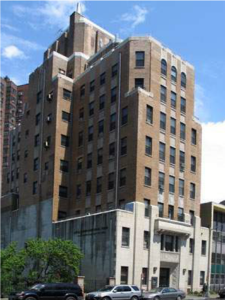
While initially easy to miss, especially since it is now partially covered with scaffolding, the façade leads to significance in two different directions. First it testifies to an enormously important aspect of Jewish immigrant history and secondly reflects the complex relationship between tradition and modernity, still playing itself out in the 21st century.
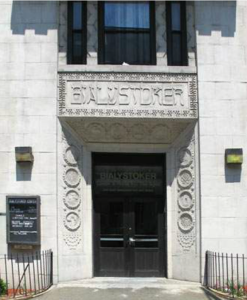
New York City, and specifically the Lower East Side was in 1910 the largest Jewish city in the world. Moreover, the Lower East Side was arguably the most densely populated place on the planet. These facts alone set the stage for a momentous transformation of the downtown Jewish population. The predominately Jewish Bialystok suffered terrible depravations and violence during the Russian Revolution starting in 1906, World War I and subsequent upheavals. Therefore a mass emigration occurred both before and after WWI that led to a diaspora of Bialystoker Jews to Chicago, Buenos Aires, Melbourne and Tel Aviv. New York’s was easily the largest. The first Bialystoker landsmanschaft was established in 1886 and the Bialystoker Center in 1919. The current building opened to great celebration in 1931 with the Forward declaring, “Bialystok is now on East Broadway.” As the Bialystoker Jews banded together they offered services and collected money not only to help their brethren here in New York, but also to help rebuild Bialystok in was is now Poland. This strong sense of identity, “forever a Bialystoker,” entered the complex immigrant mix in 1920s–1930s Lower East Side. Many Jews resisted American values and assimilation and did not even become citizens or learn to speak English. Many dug in and lived as if they had never left home, while many others attempted to adjust to modernity, and sometimes even completely abandoning Jewish life. It was complex and bewildering for thousands of immigrants and their descendants and the Bialystoker Center was at the center of much of it.
The façade of the Bialystoker Center expresses much of this complexity that these Jews found themselves in 1931. The grand doorway boldly proclaims “Bialystoker” in Hebraicized English lettering. The pride of Judaic-Polish ancestry is proclaimed simultaneously as the English language, and all it implies, is asserted. Above the entrance doorway the stone façade is capped by a grand balcony. Art Deco stylized reliefs ascend between the three central windows for the eighth floors of golden brick. In its time it was one of the tallest and grandest buildings on the Lower East Side. It is clear the architect Henry Hurwit wanted to send as inclusive a visual message as possible.
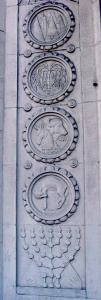
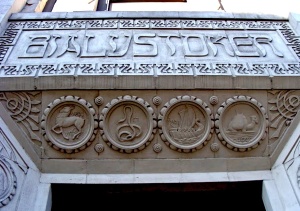
The recessed doorway is concise, assertive and revealing. The 12 Tribal symbols flank the doorway: 4 on the right, 4 on the soffit above and 4 on the left. The images are ensconced in roundels that approximate a Hebraic formulation (right to left) of Jacob’s ‘blessings’ found at the end of Genesis. They start on the right with the first born, Reuben, travel up, cross the transept and down the left side to the final child, Benjamin.
The exact order and most of the images actually follows the Midrash Rabbah on Numbers 2:2 that expands on the arrangement of the tribes around the Tent of Meeting in the wilderness: “The Children of Israel shall encamp, each man by his banner according to the insignias of their fathers’ household.” This midrash codifies the information from Jacob’s blessings (Genesis 49) and Moses’ blessings (Deuteronomy 33) into a blueprint for the color and image for each tribe’s flag or symbol.
At the base of each side panel there are stylized representations of the Temple Menorah superimposed over a Star of David / pyramid design anchored by schematic sunrises. These images link this building on East Broadway with both the ancient Temple and the growing Zionist movement in Palestine. Reuben’s mandrakes, a gift of fertility for both his mother and Rachel, effectively sidesteps Jacob’s stinging castigation while retaining its sexual undertones. Similarly the violent Simon and Levi are symbolized discreetly. Simon is represented by a massive city gate, alluding to the city of Shechem, while Levi gets off scot-free with a depiction of the High Priest’s breastplate, the Choshen HaMispat that contained the Urim and Tumin. The right side panel is then completed with the Lion of Judah confirming Jacob’s blessing of kingship to his fourth born son.
Directly underneath the massive Bialystoker panel are the next four sons. Issachar is normally represented as a “strong boned” donkey, meaning, according to Rashi, bearing the burden of Torah. Here the unknown artist has depicted him as a camel, similarly able to bear heavy loads but also alluding to a Middle Eastern sensibility. An ancient Phoenician single-masted ship aptly represents Zebulun as the industrious partner to Torah-learning Issachar. Clearly the residents of the Lower East Side recognized this time-honored paradigm. The snake of Dan evokes his role of extracting justice (dan – din) from Israel’s enemies. The quickness of a stag echoes, again according to Rashi, the prompt fertility of Naphtali’s crops, i.e. the quick success of his labors.
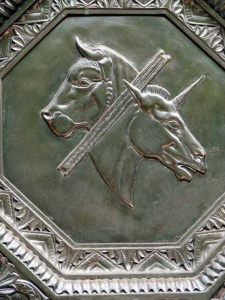
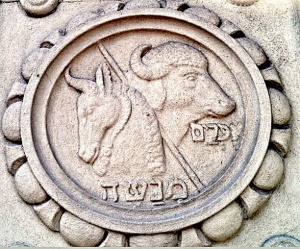
The multiple tents of Gad reflects his military prowess while Asher’s agricultural bounty, symbolized by a tree, reflects not only plentiful bread but also the luxury of oil. As is typical of many renderings of the 12 Tribes, Joseph is here replaced by his two sons, Ephraim as a stalwart bull and Menashe as a wild ox. In this double tribe roundel, Menashe could be seen also as a unicorn, a mystical medieval creature. Finally Benjamin is symbolized as a wolf, combining cunning with a ferocious nature found in the midrash.
For Jews of the Lower East Side in the 1930s these tribal signs reverberated with familiar meanings facilitated by the ubiquitous Yiddish spoken and understood by almost everyone. Whether observant or not, the general biblical literacy was guaranteed by the high proportion of biblical and Talmudic phrases and terms in everyday Yiddish. The creator of these panels knew he was speaking his audience’s language. These symbols effectively pushed the button that led directly to tradition and texts.
The 12 Tribes here in the Bialystoker Center may be one of the earliest expressions of the notion of “diversity” in a contemporary Jewish context. The embrace of Art Deco in this communal construction signaled this immigrant community’s clear wish to establish roots in contemporary “modern” society while affirming its Jewish identity. It was a deeply significant moment.
The banners of the 12 tribes are used in another remarkably similar Art Deco setting a bare 5 miles uptown. The cathedral-like Temple Emanuel at Fifth Avenue and 65th Street have three sets of bronze entry doors on Fifth Avenue that depict almost identical symbols of the 12 tribes, frequently utilizing the exact same image. Completed in 1930, it is considered an Art Deco masterpiece as well as the largest synagogue in the world. The curious visual link with the uptown Reform bastion of wealth and power and downtown landsmanschaft Bialystoker causes one to wonder if the Bialystoker artist was consciously trying to connect with his uptown, powerful and so very Modern brethren.
The contemporary use of these symbols, first mentioned in the Torah and then formalized in midrash, is inevitably ironic. When the tribes entered the land they of course settled “under their banners.” Nonetheless, during the First Temple period the tragic division between the Kingdom of Judah and the Kingdom of Israel finally resulted in the destruction of the Temple and the tribes themselves. After the first Exile, the tribes effectively disappear, leaving just Jews. Over the millennia we have grown to be an extremely diverse people, and the Jews of the Lower East Side, although predominately from Eastern Europe, were likewise wildly diverse in practice, belief and custom. In the throes of change, growth and hope it is remarkable that the banners of the original 12 tribes should appear as the banner itself of the Deco Bialystoker Center, summoning all simultaneously to tradition and modernity.
We should do everything in our power to preserve this significant architectural gem. Only in appreciating our past can we gain the wisdom to shape our future. For more information go to www.friendsofthelowereastside.org.
Elissa Boyarin, an expert in urban geography, has done considerable research on the Bialystoker Center and related concerns. This review is deeply indebted to her work and the distinguished panel, including Joyce Mendelsohn, Linda Jones, Laurie Tobias Cohen, Rebecca Kobrin (author of “Jewish Bialystok and Its Diaspora”), Suzanne Wasserman and Mitchell Grubler, which publicly discussed this preservation project on February 5, 2012.